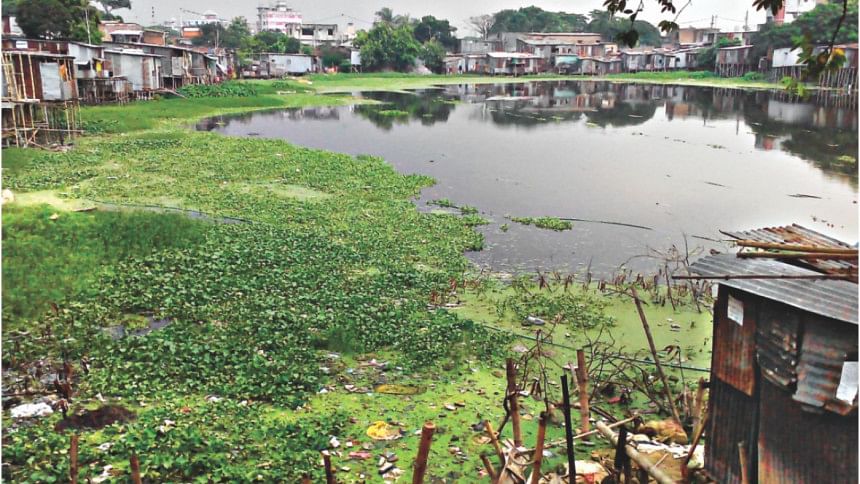A RAY OF HOPE

Arjun could not stop clapping as he saw around 15 swans by the bank of a pond. Excited, the three-year-old went closer to get a better look. But the birds quickly went into the water creating gentle ripples and floated away.
Arjun kept on clapping.
“Look how happy he is,” said his uncle Sawpon Kumar Saha. Meanwhile, Sawpon's daughter Bunon was running around and kept on calling Arjun to chase her.
The three were by the reservoir inside a park in Uttara Sector 4.
“We often come here,” said the resident of Uttara. “The children can play for as long as they want here while I walk by the pond.”
While most of the capital's ponds have either been polluted or lost to urban sprawl, this reservoir remains as a ray of hope for the dwellers. It is being maintained with great care by the authorities concerned.
The pond is not only surrounded by trees, there are also flowers by its banks enhancing the aesthetic beauty of the area.
There is also a walkway around the pond for people to walk. If they get tired, they can sit on the benches by the banks and relax while enjoying the tranquil water.
The park, comprising a field, reservoir and a playground for children, is being maintained by Uttara Sector 4 Kalyan Samity (welfare association). The total area is around six acres.
Mohammad Quaisarul Islam, general secretary of the Kalyan Samity, said they are maintaining the park including the pond since 2005. The pond is there since the beginning of the Uttara Residential Area. Rajuk re-excavated it in 2005, he said.
Sajib, a resident of Kurmitola, often visits the pond. When this correspondent met him, he was sitting by it. “My family members and I drop by regularly. The park is well maintained and beautiful.”
“I love to spend time by the pond most,” he smiled. “Look how peaceful it is.”
Ismat Tahmid and Shahad, residents of Sector 4, were jogging by the reservoir.
“I come here to jog almost every day,” said Ismat. She paused, took a deep breath and said, “The air is so clean here with the fresh smell of grass.”
Meanwhile, Shahad smiled heartily. “I mostly sit by the water,” he said.
Quaisarul Islam, general secretary of the Kalyan Samity, said, “We maintain the park and the reservoir on a regular basis. Even people from other neighbourhoods visit the area to enjoy the atmosphere.” He said Rajuk constructed the walkways in 2010.
The park stays open from morning to 9:00pm.
There is 90 staff including 20 cleaners, three gardeners and 50 security guards ensuring the safety of the neighbourhood as well as overseeing the cleaning activities, he added.
POND IN SECTOR 2
There is also a reservoir on the premises of the Armed Forces Division in Uttara Sector 2.
The authorities are renovating the pond and it will be turned into a swimming pool, said Nayek Nasim Siddiq Eliyas. He said departmental swimming competition is held there.
The renovation work is suspended for now. It will resume after the rainy season, he added.
(Edited by HASAN MEER)
Result of negligence
Once the capital's Bhashantek was called fondly called Kahar Daria (huge water body) as the entire area used to transform into a wetland during the rainy seasons.
There used to be three ponds in the area that would get filled with water to the brink.
According to locals, boats of different sizes plied the area on a regular basis. But boat communication stopped since the construction of an embankment after the 1988 flood, they added.
Also, water of the ponds became polluted around 15 years back while major portions of the reservoirs were illegally grabbed, said Mohammad Abbas, a resident of the area.

Among the ponds, two were at Block-C and another at Block-E inside the Bhashantek colony.
The reservoir on the western side of Block-C was around 16 bighas while the one on the eastern side around 20 bighas. The pond at Block-E was around 16 bighas.
The water of the ponds was clean and used by many. The water bodies were also filled with fish, said Abbas.
According to locals, around 96 floating families were brought in the Bhashantek area during the 70s under a rehabilitation programme. The ponds were given to them so that they could cultivate fish in.
But over the years, structures were built upon those illegally. Also, quality of the water deteriorated drastically due to continuous dumping of waste. Negligence of the authorities concerned played a major role behind the present situation of those vital organs.
However, Sheikh Sohel Rana, sub-divisional engineer of the National Housing Authority (division-1), said there are two ponds in the area while the other one is a wetland. During construction of the embankment, a large amount of soil was dug up in the area, which eventually became the wetland.

A project has been taken by the National Housing Authority for the slum dwellers and under which 10,000 flats will be given to them at a low cost. A total of 2,600 people got plots from the government in Block A, B, C, D and E of the colony, he said.
Abdul Mannan, a resident of the area, said those who got possession of the land, built structures encroaching upon the pond. Makeshift tin-shed structures, rickshaw garages and shops were constructed on the filled-up land, he said.
The ponds were dug up during the British period under private initiatives. But they were turned into khas (government) land during the Pakistan period, he said. There were vast areas around the pond that were being used for rice cultivation.
The entire area is around 96 acres including a school, ponds and open space.

 For all latest news, follow The Daily Star's Google News channel.
For all latest news, follow The Daily Star's Google News channel. 



Comments